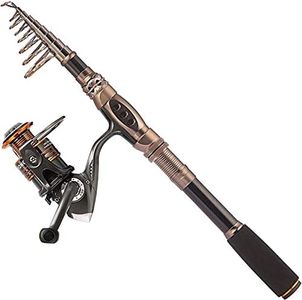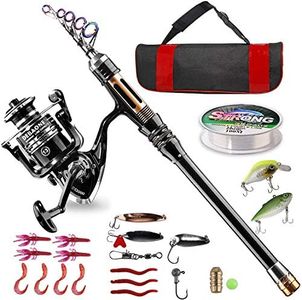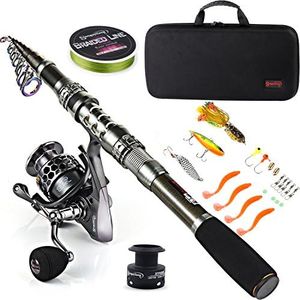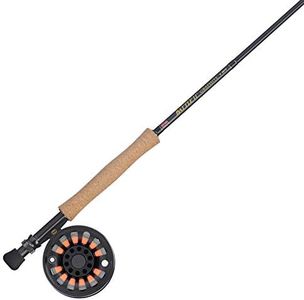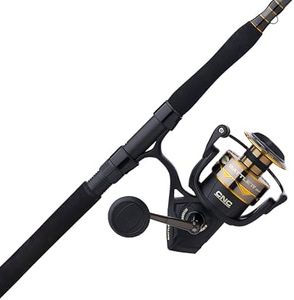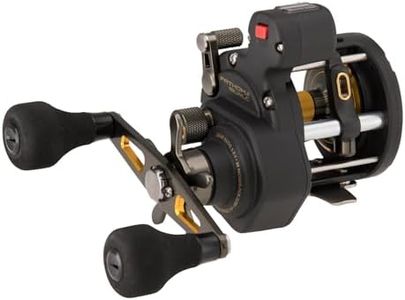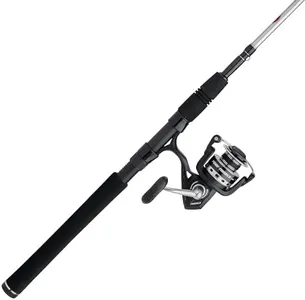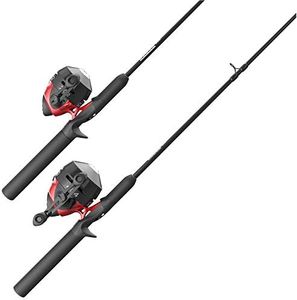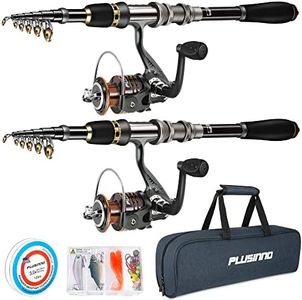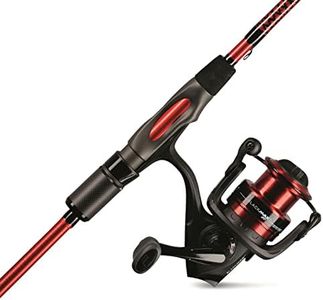We Use CookiesWe use cookies to enhance the security, performance,
functionality and for analytical and promotional activities. By continuing to browse this site you
are agreeing to our privacy policy
10 Best Fishing Rods And Reels
From leading brands and best sellers available on the web.Buying Guide for the Best Fishing Rods And Reels
Choosing the best fishing rod and reel set can make a big difference in how much you enjoy your time by the water. It's important to think about what type of fishing you want to do, where you'll be fishing, and your own skill level. Getting the right rod and reel will help you cast accurately, feel bites, and reel in fish with ease. Learning about the main features of rods and reels will help you make the decision that's best for your needs.Rod LengthRod length is the measurement from the tip of the rod to the end of the handle and it affects how far you can cast and how much control you have over the fish. Shorter rods, under 6 feet, are good for short, accurate casts and are often used in tight spaces or when fishing from a boat. Medium rods, between 6 and 7 feet, offer versatility and work well for a mix of casting distance and accuracy, making them a great all-around choice. Longer rods, over 7 feet, allow for longer casts, which is useful when fishing in open waters or from the shore. To pick the right length, consider where you'll mostly fish and whether you value casting distance or pinpoint accuracy more.
Rod PowerRod power refers to how much force is needed to bend the rod and it is sometimes called the rod's 'strength'. It ranges from ultralight to heavy. Ultralight and light rods are for smaller fish and delicate presentations, making them good for panfish or trout. Medium rods are the most versatile, suitable for a range of fish sizes and techniques. Heavy rods are used for bigger fish and heavier lures, often in situations where you need to pull a fish out of thick cover. Choose the power based on the type and size of fish you expect to catch.
Rod ActionRod action describes where along the rod's length it flexes when pressure is applied. Fast action rods bend mostly at the tip, which makes them sensitive and good for detecting bites and setting the hook quickly. Moderate action rods bend more in the middle, making them more forgiving and useful for casting further with a variety of lures. Slow action rods bend throughout most of their length, which is best for casting light baits and fighting smaller fish. Consider your preferred fishing technique and fish species to decide the right action for your needs.
Reel TypeReels come in different types, with the most common being spinning, baitcasting, and spincast. Spinning reels are the most user-friendly and suitable for beginners because they're versatile and easy to handle. Baitcasting reels are preferred for heavier lines and lures and are used by experienced anglers who want more control with their casts. Spincast reels are simple to use with a push-button design, making them great for kids or occasional anglers. Choose your reel type based on your comfort level and the kind of fishing you want to try.
Gear RatioGear ratio tells you how many times the spool turns with one turn of the reel handle. A higher number like 6:1 means faster line retrieval, which is good for quickly bringing in your line and working lures that need speed. Lower gear ratios like 4:1 provide more cranking power for reeling in bigger fish or using heavier baits. Think about the techniques and the species you'll fish for: faster ratios for active lure fishing, slower for larger, hard-fighting fish.
Rod and Reel MaterialThe materials of rods and reels affect their weight, sensitivity, and durability. Rods are commonly made from fiberglass, graphite, or a combination. Fiberglass rods are more durable and flexible, good for beginners or rough use. Graphite rods are lighter and more sensitive, helping you feel even the smallest bites. Reels are often made of metal or high-grade plastics. Pick a material based on whether you prioritize sensitivity and weight, or toughness and longevity.
Line CapacityLine capacity means how much fishing line the reel can hold, and this is shown for different line thicknesses. More capacity is useful for bigger fish or when casting long distances. Smaller capacity is fine for lakes, ponds, or smaller fish. Make your choice depending on where you'll fish and what you're targeting—bigger waters and fish need more line, while smaller, local spots may not.
Handle Design and ComfortThe handle design includes the shape, length, and material of the handle on both rod and reel. Some handles are made longer for two-handed casting or for fighting larger fish, while shorter handles are lighter and easier to control for precise moves. The grip material, like cork or EVA foam, impacts comfort during longer fishing sessions. Choose a handle that feels comfortable in your hand and suits how you'll use the rod—whether for light, quick casts, or for strong, sustained fights.
